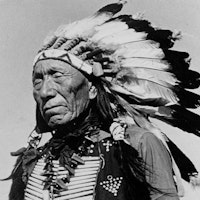The first peace is that which comes within the souls of people when they realize their relationship, their oneness, with the universe and all its powers, and when they realize that at the center of the universe dwells Wakan Tanka (the Great Spirit), and that this center is really everywhere, it is within each of us.
Black Elk [Heȟáka Sápa]

The True Peace
Topic: Justice, Vision, & Leadership
The first peace, which is the most important, is that which comes within the souls of people when they realize their relationship, their oneness, with the universe and all its powers, and when they realize that at the center of the universe dwells Wakan Tanka (the Great Spirit), and that this center is really everywhere, it is within each of us.
This is the real peace, and the others are but reflections of this. The second peace is that which is made between two individuals, and the third is that which is made between two nations. But above all you should understand that there can never be peace between nations until there is known that true peace, which, as I have often said, is within the souls of men.
Heȟáka Sápa, commonly known as Black Elk, was born in December 1863 along the Little Powder River in what is now Wyoming. He was a member of the Oglala Lakota (Sioux) and a second cousin to the renowned war leader Crazy Horse. From a young age, Black Elk experienced profound spiritual visions that would shape his life and destiny. At the age of nine, during a severe illness, he had a vision in which he encountered the Six Grandfathers, spiritual beings who bestowed upon him gifts and powers, including the ability to heal. This vision set him on the path to becoming a wičháša wakȟáŋ, or holy man, a role he embraced throughout his life.
Black Elk's life was marked by significant historical events and personal transformations. He participated in the Battle of the Little Bighorn in 1876 and witnessed the tragic Wounded Knee Massacre in 1890. In the late 1880s, he traveled to Europe with Buffalo Bill's Wild West Show, where he sought to understand the ways of the white people. Upon returning to the United States, he became involved in the Ghost Dance movement, which aimed to restore the Native American way of life. Despite the suppression of this movement, Black Elk continued to serve his people as a healer and spiritual leader, blending traditional Lakota practices with his later conversion to Catholicism in 1904. He became a catechist, teaching Christianity while maintaining his Lakota spiritual beliefs.
Black Elk's legacy extends beyond his lifetime through his contributions to literature and spiritual teachings. His autobiographical accounts, shared with poet John G. Neihardt and anthropologist Joseph Epes Brown, were published in the influential works "Black Elk Speaks" and "The Sacred Pipe." These books have inspired generations and contributed to the revival of Native American culture and spirituality. Black Elk's ability to integrate his Lakota heritage with his Christian faith exemplifies his resilience and adaptability. His life and teachings continue to resonate, symbolizing a bridge between cultures and a testament to the enduring spirit of the Lakota people.
The Sacred Pipe
Black Elk, Nicholas, and Joseph Epes. Brown. The Sacred Pipe: Black Elk's Account of the Seven Rites of the Oglala Sioux. Univ. of Oklahoma Press, 2003, [Black Elk, The Sacred Pipe (1953)].

Black Elk [Heȟáka Sápa]
Theme: A Vision of America

About This Black Elk (Heháka Sápa) Quotation [Commentary]
Heháka Sápa (Nicholas Black Elk). From “Frithjof Schuon and the American Indian Spirit: Interview with Michael Fitzgerald”
Heháka Sápa (Nicholas Black Elk) was a famous wičháša wakáŋ (medicine man and holy man) and heyoka of the Oglala Lakota (Sioux) who lived in the present-day United States, primarily South Dakota. He was a second cousin of the war chief Crazy Horse.
These are the words of Fools Crow, the most renowned Lakota Sun Dance chief of the twentieth century: My uncle, Black Elk, became a Roman Catholic in 1904, and I am certain his first name, which was Nicholas, was given to him at that time. Black Elk was very interested in the teachings of the Roman Catholic Church, and spent many hours talking to the priests about it. When he and I were discussing it one day, Black Elk told me he had decided that the Sioux religious way of life was pretty much the same as that of the Christian churches, and there was no reason to change what the Sioux were doing. We could pick up some of the Christian ways and teachings, and just work them in with our own, so in the end both would be better. Like myself, Black Elk prayed constantly that all peoples would live as one and would cooperate with one another. . . .
My uncle, the renowned Black Elk, has earned a place above all of the other Teton holy men. We all hold him the highest. I have never heard a bad word about him, and he never said a bad word about anyone. All he wanted to do was love and serve his fellow man. . . . In the Indian custom, he was also a father to me. I stayed with him quite often, and sometimes for long periods of time. We also made a few trips together and over the years talked about many things. I learned a great deal about Wakan Tanka, prophecy, and medicine from him.
—Thomas Mails, Fools Crow. [“Frithjof Schuon and the American Indian Spirit: Interview with Michael Fitzgerald” Vincit Omnia Veritas. III,2]
Additional Black Elk (Heháka Sápa) Quotes
Resources
Related Quotes
Copyright © 2017 – 2025 LuminaryQuotes.com About Us